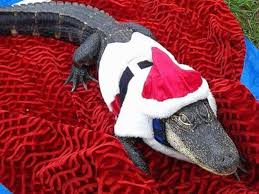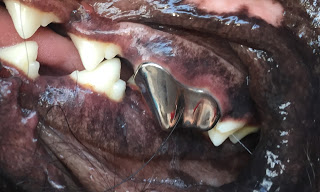Clothes-Wearing Pet Alligator
Mary Thorn & Rambo
 Mary Thorn is no regular pet guardian. Yes, she has dogs, but she also has a pet squirrel and an Alligator that she dresses in clothing. Mary battled the State of Florida to keep "Rambo," a 6-foot gator that she considers part of the family. The calm and collected reptile also is a therapy animal for troubled children.
Mary Thorn is no regular pet guardian. Yes, she has dogs, but she also has a pet squirrel and an Alligator that she dresses in clothing. Mary battled the State of Florida to keep "Rambo," a 6-foot gator that she considers part of the family. The calm and collected reptile also is a therapy animal for troubled children.
Rambo was four years old when he came to live with Mary. Mary originally got Rambo and five other alligators that were in a 10-gallon tank. They all lived in a dark closet for the first four years of their lives. They were never exposed to sunshine and all they could do in the cramped tank was to rock back and forth.
The tank full of Alligators was dropped off at the place where Mary was doing an alligator show. Mary had many previous years of experience with alligators before Rambo and says living in Florida you can find them in every ditch, every pond and every lake.
Normally alligators don't get sunburned, but after living their first four years in a dark closet, all six alligators were not able to be exposed to the sun at all. Two of the other five alligators actually died of sun exposure.
The law in Florida is that you have to have 2.5 acres to keep an alligator over four feet, and Mary doesn't have that amount of land. However, since Rambo is sun sensitive, the 2.5 acres wouldn't benefit him in the least. Mary provided a veterinarian letter to the State of Florida stating two of the other alligators died from sun exposure and that Rambo was allergic to the sun.
Now that Rambo can stay, he has his own bedroom not only with a regular bed and a pool, but a television and refrigerator as well.
 The plan wasn't originally to dress Rambo in clothing, but Mary needed to find a way to keep him from getting sunburned. She had some scraps lying around and one day decided to make an outfit for him. Now, if Rambo doesn't have his clothes on, he just mopes around the house until he gets dressed.
The plan wasn't originally to dress Rambo in clothing, but Mary needed to find a way to keep him from getting sunburned. She had some scraps lying around and one day decided to make an outfit for him. Now, if Rambo doesn't have his clothes on, he just mopes around the house until he gets dressed.
Rambo became a performer who was taught to sit on props and take pictures with people. Unfortunately, part of the new condition in which Mary got to keep Rambo no longer allows him to do public appearances. Mary doesn't agree with this, as she states Rambo has never had an aggressive moment in his life.
Rambo still gets many visitors and does therapy with children who will sit with him and tell him their problems and why they can't get along with people. Rambo will just sit there and listen to them.
Rambo also lives with five dogs, two opossums and a squirrel. Mary says when someone in her neighborhood finds an animal that has been injured; it ends up in her house. Everyone gets along and Mary states that Rambo acts like her five dogs.
In captivity, alligators can live 100 years and about 35 years in the wild. Mary doesn't recommend alligators as pets and would rather see them live in a natural habitat and not the way Rambo is forced to live.
See Rambo on Facebook
500 Of The Most Absurd And Horrifying Things That Happen In Nature!
Ezra Reid Ross - Nature is the Worst: 500 Reasons You'll Never Want To Go Outside Again
 E. Reid Ross tells us about 500 of the most absurd and horrifying things that happen in nature. From murderous squirrels to farting fish, "E" uncovers and revels in some of Mother Nature's ugliest moments.
E. Reid Ross tells us about 500 of the most absurd and horrifying things that happen in nature. From murderous squirrels to farting fish, "E" uncovers and revels in some of Mother Nature's ugliest moments.
So why is nature so bad? "E" tells us it depends on where you are and what you're involved in, but that there's plenty out there to be afraid of. You don't have to be an arachnophobia or afraid of the deep water to find a lot to be terrified of. As a result, "E" decided to compile 500 of these reasons.
Some of the top things you should be frightened of, according to "E," are plants and fungus. He tells us he could never have imagined that there was a type of thorn bush that could kill you if you just walk passed it. In New Zealand, if you go off the nature paths for 10 seconds, you could be quivering to a quick death just by brushing up against a stupid bush.
There are also plants that consume bugs and animals. While they are not growing legs and rampaging the countryside mauling livestock, it is more of a slow process. There is one plant that is even capable of eating sheep. It does this by trapping the sheep on purpose. When the sheep dies, the plant then soaks up the nutrients from the where the corpse lands.
 There is also a bacterium that specifically targets your eyeballs. It will actually work its way underneath your contact lens, and if left unchecked, will devour your eyeball.
There is also a bacterium that specifically targets your eyeballs. It will actually work its way underneath your contact lens, and if left unchecked, will devour your eyeball.
People living in Florida have to deal with alligators and crocodiles, and a recent discovery shows that crocodiles are actually able to shimmy up trees after their prey. They have also been known to set traps with their mouth. They put little sticks for nest building in the bottom of the their jaw, open wide, and wait for a bird to try and collect the sticks for their nest. When the bird lands, the alligator closes its mouth and catches them.
"E" also tells us about those cute little prairie dogs that are murderers! Of course they have to compete with other animals for land and food, but it is still hard to see them murder a baby squirrel while you're enjoying the scenery looking out over the vista at the Grand Tetons.
 You would be surprised that while herring fish are benign, they are also very vocal. However, most of the communication comes from the rear ends. They communicate via "farts." You've probably seen footage of them moving in a group that looks like it has been choreographed? Well, they don't bump into each other because they are communicating with their farts.
You would be surprised that while herring fish are benign, they are also very vocal. However, most of the communication comes from the rear ends. They communicate via "farts." You've probably seen footage of them moving in a group that looks like it has been choreographed? Well, they don't bump into each other because they are communicating with their farts.
So where does "E" get all of his information? He states he has been writing articles on horrible nature since 2011. He also looks at zoological charts and wants to give a shout out to Carly Brooke at the Featured Creature, because she has been a fantastic source of information for him.
Ezra Reid Ross resides in Maryland, and is a columnist/editor at Cracked.com. He's no scientist, that's for sure, but with a background in military intelligence and law enforcement, he's not just the author this book needs, he's exactly the one it deserves.
Visit Publisher
Will Your Dog's Chew Bone Injure Her Teeth? - Dr. Debbie
 Even veterinarians can make bad choices when it comes to their pet's health. I learned this when I discovered my dog, Nikki, had a broken tooth. The cause was a chew item I thought was a safe option for her to gnaw on. But I was wrong - no chew item is risk free. Sadly my Nikki had to crack three teeth for me to learn that lesson.
Even veterinarians can make bad choices when it comes to their pet's health. I learned this when I discovered my dog, Nikki, had a broken tooth. The cause was a chew item I thought was a safe option for her to gnaw on. But I was wrong - no chew item is risk free. Sadly my Nikki had to crack three teeth for me to learn that lesson.
Oh yes, it was three broken teeth! But more on that later...
Considering Chew Options
What chew options are there? As the owner of a large powerful chewer I considered the possibilities for my dog. She has a sensitive stomach and cannot tolerate edible bones or preserved rawhide products. Thank goodness, because feeding my dog pig snouts or pizzles just makes me want to gag. I'm not a fan of real bones - too many patients with broken teeth, gastrointestinal blockages and even one with a bone shard migrating through the side of a dog's throat. Soft plastic toys don't survive the first two minutes with her, and plush toys quickly lose eyes, limbs and squeakers with her near surgical precision. So I chose to offer synthetic Nylabone style bones to deal with her chewing drive. Nikki loves the flavors and happily chews away for long periods of time. When the bone looks damaged, I throw it away. It seemed like the perfect solution for a vigorous chewer.
Discovering Her Broken Tooth
While brushing Nikki's teeth, I noted a fracture of her upper fourth premolar tooth. This is the largest cheek tooth on a dog or cat's upper jaw, which serves to chew and grind food. The outer layer of the tooth was sheared off, just like a shelf of ice cracking off an iceberg. This type of fracture is common from dogs chewing on an object harder than tooth enamel. Common culprits for this type of tooth damage include antler chews, Nylabones, real bones or ice.
What to Do With Broken Teeth?
Not all tooth fractures are created equal. An uncomplicated tooth fracture is one in which only the enamel is broken. The tooth is vulnerable to further injury but is not immediately causing the pet pain. A complicated fracture is one in which the break extends beyond the enamel into the pulp chamber.
The pulp of a tooth is the inner layer where the nerve and blood supply runs. Exposure of the pulp not only causes pain, but serves as direct pathway for oral bacteria to cause a tooth abscess or spread through the bloodstream.
How to Treat a Tooth Fracture?
A complicated tooth fracture requires either a root canal or surgical extraction. Leaving a complicated tooth fracture untreated is NOT an option. These teeth hurt and shouldn't be ignored. Pets won't whine or cry out in pain with broken teeth, but rather suffer in silence. But after a diseased tooth is addressed, owners commonly note their pet's overall activity and attitude improve.
 The preferred treatment for a complicated tooth fractures is a root canal. During a root canal the contents of the pulp are removed, filled in, and the tooth is sealed. After the root canal therapy the tooth is still functional for normal chewing activities.
The preferred treatment for a complicated tooth fractures is a root canal. During a root canal the contents of the pulp are removed, filled in, and the tooth is sealed. After the root canal therapy the tooth is still functional for normal chewing activities.
If a root canal cannot be pursued, then the tooth should be surgically extracted. This removes the source of pain and potential infection. However, surgical removal of broken teeth may affect the pet's ability to chew on that side in the future.
Uncomplicated tooth fractures aren't treated as above, but rather may need outward support of the area with bonding restoration.
My Dog's Dentist Visit
Dental cleanings and extractions are a daily service at most veterinary practices, but root canals and tooth restorations aren't commonly available at general practices. I knew I could pull Nikki's tooth, but to save this tooth in my young dog, I'd need to see a veterinary dental specialist.
Nikki and I arrived at Arizona Veterinary Dental Specialists where she was evaluated by Dr. Chris Visor who determined that she had an uncomplicated fracture of her premolar and small uncomplicated breaks on two molars.
Her premolar fracture was limited to the enamel, luckily sparing pulp damage, which means she wasn't in pain. But the damaged tooth would be at risk for further injury, so she was fitted for a restoration with a metallic crown (porcelain isn't durable in pets so it's not commonly used). The two other broken teeth had minor damage, so the rough edges were drilled smooth and the tooth surface bonded.
Lesson Learned
After her crown placement, Nikki can't chew on hard chew bones like before. If she did, it could risk damage to her crown as well as her other teeth. Veterinary dentists warn dog owners to try this test of your dog's chew item - if you whack your knee with your dog's chew item and it hurts you, it'll likely break her teeth.
Now I can only imagine scores of dog owners going to their doctors with knee pain.
Take Away Tips: Can You Detect Your Pet's Broken Tooth? Most broken teeth are detected during a physical exam by your veterinarian, but some observant pet owners may discover clues to their pet's broken tooth.
1. No complaining. Don't expect your pet to cry or whine. People complain loudly when a tooth hurts, but pets just don't verbalize dental pain.
2. Uneven tartar accumulation. Due to tooth pain, the pet chews on one side more, the "good side." Tartar builds up more on the "bad side."
3. Dark spot on tooth. Enamel is evenly white, but darker or grey spots could indicate exposed pulp or dentin at the site of a fracture.
4. Draining wound present below the eye. A broken upper premolar or molar with an infected root can cause a draining wound under the eye.
If you notice any of these signs, get your dog to a veterinarian right away.
Featured veterinarian known as "Dr. Debbie" on national pet radio program, Animal Radio. Ebook author of "Yorkshire Terriers: How to Be Your Dog's Best Friend"; "Pugs: How to Be Your Dog's Best Friend"; "Mini Schnauzers: How to Be Your Dog's Best Friend"; and "Shih Tzu: How to Be Your Dog's Best Friend." Dr. Debbie's books.
Visit Website
5 Things Everyone Should Know About Seeing Eye Dogs
Robert Semrow, Listomania
 Dorothy Eustis opened up the first school for Seeing Eye Dogs in America on January 29, 1929. She had been contacted by a blind person named Morris Frank after his family read an article about the dog training she was doing in Germany for blind veterans of World War I. Their remarkable story, and what it has led to, has been an inspiration for many, including myself. So much so that when we created our Pet X Talks series, that was one of the first Pet X Talks we did, Thank you Kate Kelly.
Dorothy Eustis opened up the first school for Seeing Eye Dogs in America on January 29, 1929. She had been contacted by a blind person named Morris Frank after his family read an article about the dog training she was doing in Germany for blind veterans of World War I. Their remarkable story, and what it has led to, has been an inspiration for many, including myself. So much so that when we created our Pet X Talks series, that was one of the first Pet X Talks we did, Thank you Kate Kelly.
To celebrate the incredible amount of people they have impacted, I thought I would share 5 things everyone should know about Seeing Eye Dogs.
To begin with, it takes nearly 18 months of training to go from puppy to guide dog and not every dog that starts the program will become a certified Guide Dog. Some estimates are as many 20-percent of the trainees do not pass and become guide dogs, as they are not proficient enough in critical skills that are essential for the safety and well being of the Guide Dog and it's person.
When Morris Frank and his seeing eye dog Buddy the 1st walked across West Street in Manhattan, he kicked open the doors of acceptance and also possibilities. Remember back in 1928 Seeing Eye Dogs were not only non-existent but there were no laws that required they be allowed in places. Fortunately, Morris made it his mission to change minds and laws and today Seeing Eye dogs have laws that allow them access where typically only people could go.
 Three of the most popular breeds that are trained to be seeing eye dogs should be no surprise; Golden Retrievers, Labrador Retrievers and German Shepherds. These breeds are well know to be calm, fiercely loyal dogs who are extremely intelligent and calm under pressure. As important, they are great companions and loving dogs who are devoted to their human.
Three of the most popular breeds that are trained to be seeing eye dogs should be no surprise; Golden Retrievers, Labrador Retrievers and German Shepherds. These breeds are well know to be calm, fiercely loyal dogs who are extremely intelligent and calm under pressure. As important, they are great companions and loving dogs who are devoted to their human.
One of the more interesting things that a Seeing Eye dog is trained to do is to refuse a command if it is unsafe for the dog or the human. This is so important, especially at busy streets, when that human is putting absolute faith in the dog to guide both of them safely.
A typical career span for a Seeing Eye dog is 7-10 years. This might not seem like a long time, but when you add in the training time and the 24/7 vigilance, it's a lifetime. Most Seeing Eye dogs are retired to adoptive families so that a new Seeing Eye dog can work with the human without distraction.
Seeing Eye dogs, as well as most working dogs, are so inspiring by their selfless nature. They live to serve and care for those around them. When you think about all that they are tasked with, it is no wonder these dogs are often referred to as four-legged heroes.
Share your experiences with Seeing Eye dogs on our Animal Radio Facebook Page.
Visit Website
Animal Radio News - Lori Brooks
 Sidewalk Sanctuaries For Dogs
Sidewalk Sanctuaries For Dogs
DogSpot, formerly known as Dog Parker, has expanded to more than a dozen cities. The idea for DogSpot started in Brooklyn, New York. DogSpot makes sidewalk sanctuaries for dog that would otherwise be stranded at the entrance of businesses where dogs are not allowed. The technology-enabled dog houses serve as a safe, legal and convenient alternative to tethering or leaving dogs in cars or out on the sidewalk. In DogSpot doghouses, there's heat and A/C, auto-sanitizing UV lights, an in-app Puppy Cam and 24/7 customer service, according to company officials. Data showed that consumer behavior changed radically, specifically that users switched where they shopped in favor of stores with a DogSpot and felt less rushed while they were shopping than when they had tied their dog up outside.
 Ed Sheehan's Wax Model Ends Up in Cat Cafe
Ed Sheehan's Wax Model Ends Up in Cat Cafe
Pop music star Ed Sheeran is such a cat lover that Madame Tussauds Wax Museum in London unveiled a wax model of the British musician at Lady Dinah's Cat Emporium - it's a cat café in London. The statue was then moved to the museum after Ed had a week to hang out with the cool cats at the cafe.
Junk Food Raccoons Relocated
A colony of raccoons that became famous for devouring junk food behind a Louisiana grocery store was successfully relocated. They were known as the "Winn Dixie Colony" after the grocery store where they regularly devoured sweet snacks and food left out for feral cats. The story goes that nearby residents had begun feeding the raccoons sweet treats to prevent them from eating the food left out for the feral cats to eat. When the cat caretakers fed them the junk food, it kept the raccoons in a separate area, so the cats could eat at the same time. Animal Control officers monitored the situation and reported seeing more than 30 raccoons that were at least 30-to-40 pounds each!
 Dog Earns Record For World's Longest Tail
Dog Earns Record For World's Longest Tail
A dog in Belgium earned himself a spot in the Guinness Book of World Records for having the world's longest tail. An Irish wolfhound named Keon gets the honor. His tail measures 30.2 inches long from the top of the bone to the tip, without including his hair, according to the Guinness World Records. Keon's tail bests the previous record holder for "Longest tail on a dog" by 1.7 inches.
 Listen to the entire Podcast of this show (#1128)
Listen to the entire Podcast of this show (#1128)





